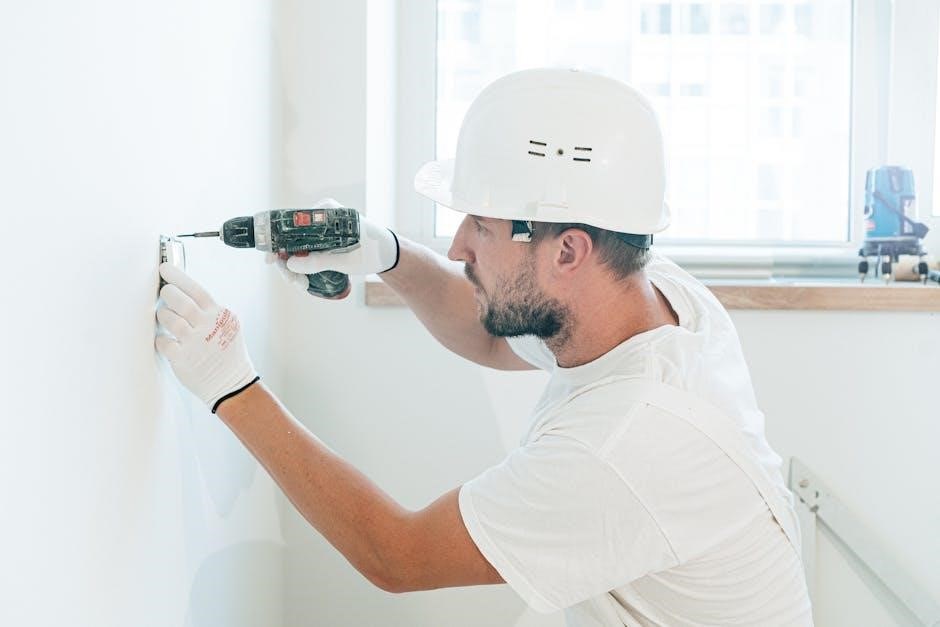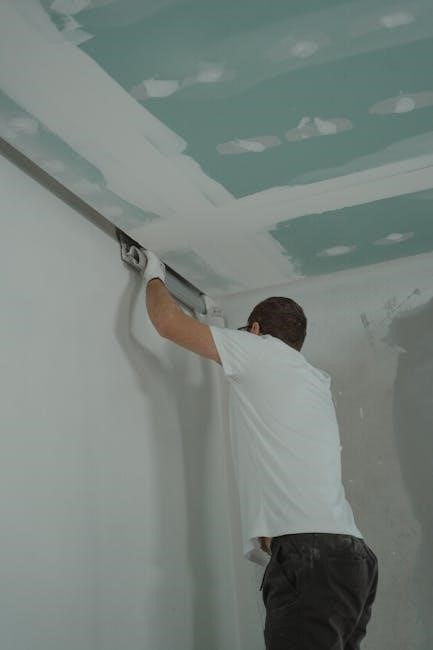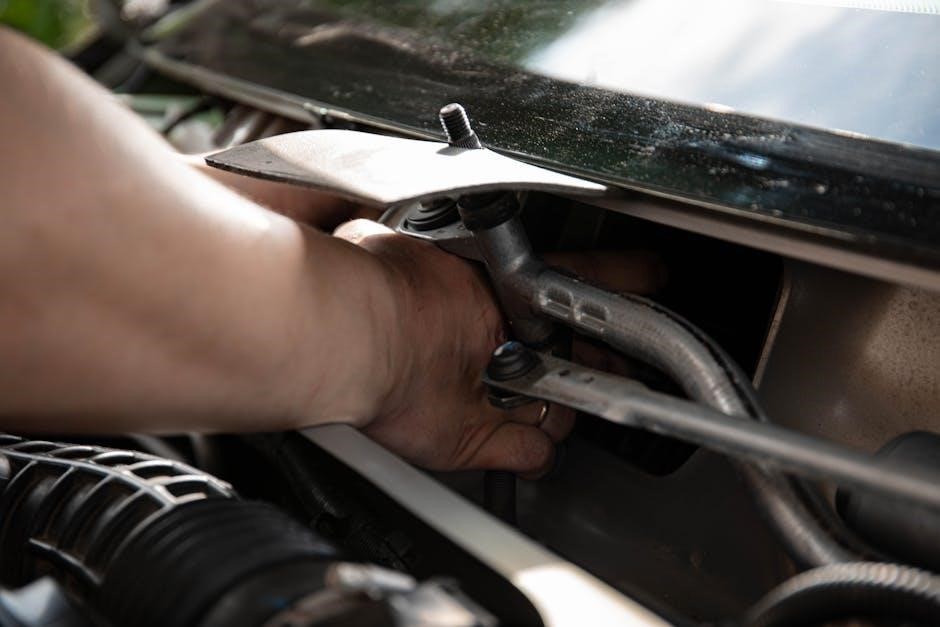The UNIRAC NXT Installation Manual provides a comprehensive guide for installing solar mounting systems, covering system components, safety protocols, and best practices. It ensures successful installations while adhering to industry standards and regulations.
1.1 Importance of Following the Manual
Following the UNIRAC NXT installation manual is crucial for ensuring safety, compliance, and system integrity. Proper adherence guarantees installations meet industry standards and manufacturer guidelines, minimizing risks of errors or structural issues. The manual provides step-by-step instructions to ensure secure and efficient mounting of solar panels. Deviating from the guidelines can lead to system malfunctions, safety hazards, and potential voidance of warranties. By following the manual, installers ensure compliance with safety protocols and achieve optimal performance of the UNIRAC NXT system.
1.2 Safety Precautions and Guidelines
Adhering to safety precautions is essential when installing the UNIRAC NXT system. Always wear personal protective equipment, including safety glasses and gloves. Ensure proper grounding and bonding connections to prevent electrical hazards. Follow all manufacturer guidelines for tool usage and system handling. Avoid installations during adverse weather conditions. Properly secure all components to prevent structural instability. Failure to comply with safety protocols can result in injuries, system damage, or non-compliance with regulations. Refer to the manual for detailed safety measures to ensure a secure and efficient installation process.
System Components and Tools Required
The UNIRAC NXT system includes rails, mounting hardware, and structural components. Essential tools like wrenches, drills, and measuring tapes are necessary for a successful installation process.
2.1 Overview of UNIRAC NXT UMOUNT Components
The UNIRAC NXT UMOUNT system consists of durable and adjustable components designed for secure solar panel installation. Key elements include rails, clamps, ground lugs, and splices. The rails serve as the structural backbone, while clamps ensure module stability. Ground lugs and bonding components provide electrical safety. Splices and fasteners enable seamless rail connections. These components are engineered for compatibility with various roof types, ensuring a reliable and efficient installation process. Proper use of these parts ensures compliance with safety standards and optimal system performance.
2.2 Essential Tools for Installation
Installing the UNIRAC NXT UMOUNT system requires specific tools to ensure accuracy and safety. Essential tools include an Allen wrench for securing clamps, a screwdriver for fastening components, and a torque wrench for proper bolt tightening. Additional tools like a measuring tape, level, and pencil are necessary for layout and alignment. Safety gear, such as gloves and a harness, is also critical. Optional tools, like a ground lug clamp and sealant tube, may be needed for specific installations. Having these tools ready ensures a smooth and efficient installation process.

Planning the Installation Layout
Properly plan the installation layout by determining rail orientation (parallel or perpendicular to rafters) and centering the installation area over structural members for stability and even weight distribution.
3.1 Determining Rail Orientation (Parallel or Perpendicular to Rafters)
Determining the correct rail orientation is crucial for a successful installation. Rails can be installed parallel or perpendicular to rafters, depending on the roof structure and desired layout. Parallel installation simplifies alignment with structural members, while perpendicular orientation may be necessary for certain roof designs. Use the NXT UMOUNT rails as straight edges to ensure accurate layouts. Proper orientation ensures even weight distribution and structural integrity, adhering to the guidelines outlined in the UNIRAC NXT manual for optimal system performance and safety.
3;2 Centering the Installation Area Over Structural Members
Centering the installation area over structural members is essential for ensuring stability and proper weight distribution; Use the NXT UMOUNT rails as straight edges to mark the center points accurately. This step ensures that the system is evenly distributed across the roof structure, minimizing the risk of uneven stress. Proper alignment and centering are critical for both pitched and flat roof installations, as outlined in the UNIRAC NXT manual. This ensures the system’s structural integrity and adherence to safety standards.

Grounding and Bonding Connections
Proper grounding and bonding connections are crucial for system safety and compliance. Ensure all components are securely connected to prevent electrical hazards and meet code requirements.
4.1 Grounding Paths and Bonding Requirements
Grounding paths ensure electrical continuity, preventing hazards and ensuring system safety. All metal components must be securely bonded to the grounding system. Use approved ground lugs and clamps to maintain reliable connections. Follow local codes and manufacturer guidelines for bonding requirements. Proper bonding ensures fault currents have a safe path to earth, protecting both people and equipment. Regularly inspect connections to prevent corrosion or loosening. Refer to the manual for specific grounding methods and bonding techniques to meet compliance standards effectively.
4.2 Ground Lug Installation and Safety Measures
Install ground lugs securely on metallic components to ensure reliable electrical bonding. Tighten all connections to the specified torque to prevent loosening over time. Use approved grounding devices that meet local electrical codes. Insulate all grounding paths to avoid unintended electrical paths. Regularly inspect lugs for signs of corrosion or damage. Follow safety protocols to avoid electrical shock during installation. Ensure all personnel wear appropriate PPE when handling grounding systems. Refer to the manual for detailed installation procedures and safety guidelines. Proper installation ensures system safety and compliance with regulations.
Step-by-Step Installation Process
The manual outlines a detailed, sequential approach to installing the UNIRAC NXT system, ensuring safety and efficiency. Follow each step carefully to achieve a secure and reliable setup;
5.1 Preparing the Installation Site
Begin by inspecting the installation area to ensure it is clean, dry, and free from debris. Verify that all structural members are intact and capable of supporting the system’s weight. Organize tools and components within easy reach to streamline the process. Plan the layout using the NXT UMOUNT rails as straight edges for accurate measurements. Center the installation area over structural members whenever possible to ensure stability. Always adhere to the manual’s guidelines for a safe and efficient setup.
5.2 Attaching Rails to the Roof Structure
Align the NXT UMOUNT rails according to the planned layout, ensuring proper orientation relative to the rafters. Mark the attachment points on the roof structure using the rails as a guide. Secure the rails using approved fasteners, ensuring they are tightly fastened to prevent movement. Double-check the alignment with a level to confirm accuracy. Verify that all connections are snug and meet the specified torque requirements. This step is critical for ensuring the system’s stability and structural integrity.
5.3 Securing Solar Modules to the Rails
Place the solar modules onto the mounted rails, ensuring they are aligned properly with the clamps. Secure the modules by tightening the clamps firmly, following the torque specifications provided in the manual. Verify that the modules are evenly spaced and aligned for optimal performance. Double-check the tightness of all connections to ensure stability. This step ensures the solar array is safely and securely attached, ready for grounding and final connections.

Roof Attachment and Flashing
This section covers proper techniques for attaching solar mounting systems to various roof types, including pitched and flat roofs. It emphasizes proper flashing installation to ensure watertight seals and prevent leaks, while adhering to the installation manual’s guidelines for secure and durable connections.
6.1 Pitched Roof Application Guide
This guide outlines the steps for securely attaching UNIRAC NXT mounting systems to pitched roofs. It details how to locate rafters, position rails, and ensure proper flashing installation. The manual emphasizes using weather-tight sealants and appropriate fasteners to prevent leaks. Specific techniques are provided for different roof materials, such as asphalt shingles or metal, to maintain structural integrity. Proper alignment and spacing of components are stressed to achieve a durable and watertight installation. Refer to the manual for detailed diagrams and material specifications.
6.2 Flat Roof Flashing Installation
The UNIRAC NXT manual provides detailed instructions for flat roof flashing installation, ensuring a watertight seal. Installers should prepare the roof surface, align flashing components with roof attachments, and secure them using approved sealants and fasteners. The guide emphasizes proper material selection and adherence to local building codes. Flashing should be tightly sealed around roof penetrations to prevent water infiltration. Follow the manual’s step-by-step process for a secure and durable flat roof installation, referencing diagrams for clarity and accuracy.
Safety Guidelines and Best Practices
Always wear personal protective equipment and ensure proper tool usage. Follow all safety guidelines to prevent accidents and ensure system integrity during installation.
7.1 Ensuring Structural Integrity
Ensuring structural integrity is critical for a safe and durable installation. Properly plan the layout, ensuring rails are centered over structural members to avoid uneven weight distribution. Use rails as straight edges for accurate layouts and verify all connections are secure. Follow grounding and bonding requirements to prevent electrical hazards. Regular inspections and adherence to manufacturer guidelines are essential to maintain system stability and safety over time. Always refer to the UNIRAC NXT UMOUNT Installation Manual for specific structural recommendations.
7.2 Emergency Procedures During Installation
In case of an emergency during installation, immediately assess the situation and prioritize safety. If electrical issues arise, disconnect power sources and evacuate the area. For falls or injuries, provide first aid and seek medical help if needed. Secure loose equipment to prevent further hazards. Document the incident and contact UNIRAC support for guidance. Regular safety drills and adherence to protocols can minimize risks. Always have emergency contact information readily available to ensure prompt response and resolution.

Troubleshooting Common Issues
This section addresses common installation challenges, such as alignment errors or grounding faults, providing step-by-step solutions to ensure system integrity and performance.
8.1 Addressing Alignment Problems
Alignment issues often arise from improper rail orientation or miscalculations during layout planning. Ensure rails are parallel or perpendicular to rafters as specified. Use the NXT UMOUNT rails as straight edges to verify alignment; Center the installation area over structural members to maintain balance. Refer to Pages 17-25 for realignment procedures. Double-check measurements and markings to prevent misalignment. If issues persist, consult the UNIRAC NXT UMOUNT Installation Guide for detailed troubleshooting steps. Proper alignment is critical for structural integrity and system performance.
8.2 Resolving Grounding and Bonding Issues
Grounding and bonding issues can compromise system safety and performance. Ensure all ground lugs are securely installed and connections are tight. Refer to Pages 31-34 for proper grounding paths and bonding requirements. Verify that all components, including rails and modules, are correctly bonded. If issues arise, inspect for loose connections or corrosion. Use the UNIRAC NXT UMOUNT Installation Guide for troubleshooting steps. Proper grounding ensures electrical safety and compliance with industry standards, preventing potential hazards during operation.
Maintenance and Inspection
Regular inspections and maintenance ensure system longevity and efficiency. Clean solar modules and inspect connections for wear or damage. Follow guidelines to maintain optimal performance and safety.
9.1 Regular Maintenance Checks
Regular maintenance is crucial for ensuring the longevity and efficiency of the UNIRAC NXT system. Schedule inspections to clean solar modules and inspect all connections for wear or damage. Check for loose hardware, corrosion, or signs of weathering. Verify that grounding and bonding connections are secure and functioning properly. Ensure rail alignments are correct and that no structural shifts have occurred. Address any issues promptly to maintain system performance and safety. Refer to the manual for detailed inspection procedures and schedules.
9.2 Cleaning and Inspecting the System
Regular cleaning and inspection are essential to maintain the UNIRAC NXT system’s efficiency and safety. Use a soft brush or hose to remove dirt and debris from solar modules and mounting components. Inspect rails, clamps, and fasteners for alignment issues or loose connections. Check for signs of wear, corrosion, or weathering on all hardware. Verify that grounding and bonding components are intact and functioning correctly. Address any damage or misalignment promptly to ensure optimal performance and compliance with safety standards.

Warranty and Support Information
UNIRAC provides comprehensive warranty coverage for the NXT system, ensuring durability and performance. For support, contact UNIRAC at www.unirac.com or visit their office in Albuquerque, NM.
10.1 Understanding the Warranty Terms
The UNIRAC NXT installation manual outlines a comprehensive warranty program, ensuring coverage for manufacturing defects and material issues. The warranty typically lasts for a specified duration, covering repairs or replacements. Proper installation, adhering to the manual’s guidelines, is essential for warranty validity. Customers should review the terms carefully to understand coverage limits and exclusions. For detailed information, refer to the warranty section in the manual or contact UNIRAC support directly. This ensures clarity and protection for both installers and system owners.
10.2 Contacting UNIRAC Support
For assistance with the UNIRAC NXT installation or troubleshooting, contact UNIRAC support through their official website or by phone. Visit www.unirac.com for detailed contact information. Their office is located at 1411 Broadway Boulevard, NE, Albuquerque, NM 87102-1545. The Marketing Department can also be reached for inquiries. UNIRAC support provides technical assistance, answers installation questions, and offers troubleshooting guidance. Ensure to have your system details ready for efficient support. This resource is available to help resolve any issues promptly and effectively.

Annexes and Additional Resources
The manual includes technical diagrams, illustrations, and a glossary for clarity. Additional resources like the Design and Engineering Guide and U-Builder tool are available for detailed planning. Visit www.unirac.com for more information and support materials to enhance your installation experience.
11.1 Technical Diagrams and Illustrations
The manual includes detailed technical diagrams and illustrations to guide installers through the UNIRAC NXT UMOUNT system. These visuals simplify complex steps, such as rail layouts, module attachment, and grounding paths. Diagrams cover components like rail splices, standoffs, and clamps, ensuring precise assembly. Cross-sectional views and 3D renderings provide clarity for roof attachment methods. Referencing these visuals ensures accurate installations and compliance with safety standards. Additional illustrations in the Design and Engineering Guide further support system planning and optimization. These resources are essential for a successful and efficient installation process.
11.2 Glossary of Terms
The glossary provides definitions for technical terms used in the UNIRAC NXT UMOUNT manual, ensuring clarity for installers. Terms like “bonding,” “grounding paths,” and “rail splices” are clearly defined. It also explains specific components like “standoffs” and “clamps.” This section helps users understand industry-specific jargon, facilitating smoother installations. By referencing the glossary, installers can ensure they are using components and following procedures correctly; This resource enhances understanding and adherence to the manual’s instructions, promoting safety and efficiency throughout the installation process.